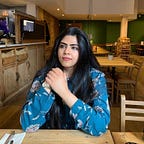FMP/ Migrant Integration — 03. Interviews with Abbas and Fatma
The formal teaching for this course culminated on the last week of July whereby after the two months of summer holidays, we would only be required to come together on a weekly basis to share our project progress and fetch feedback from tutors and classmates.
After running hither and thither in the last few units, there was great respite to be found lying under the scorching sun with a book shadowing my face during the summer break. It lasted a handful of days until the dilemma returned. I started pondering hard on how to go about looking for a purposeful research aim. A contorted line of thought lead me to realise that in order to find a research goal, I would need to learn about the problems faced by people in their journey of immigration.
External Collaboration — Aborted
The next step was then get in contact with members at the Welcoming for which I pitched a proposal to the managing director. During that time, they had closed down temporarily due to the covid outbreak but as the situation started getting better, the doors were reopened in the later weeks of August. Unfortunately, that was also the time when Afghanistan got hit by Taliban insurgency which led many civilians to flee their own country to find refuge in others. The Welcoming, like the other charities, was then actively supporting a great influx of Afghans coming to Edinburgh and therefore they couldn’t accommodate my request. A little could be achieved of collaborating with the other charities because they were facing similar demands. Unexpectedly, out of nowhere, a plate of dolma came to my rescue.
Salvation coming through a plate of Dolma
As my spouse and I were sipping coffee on a casual evening at our home in Edinburgh, a gentle knock on the door greeted us. Our neighbours brought a plate of a regional delicacy to share with us which they had prepared for their marriage anniversary on that day. Strangely, it was the very first time that we happened to meet them despite of living in flats across to each other’s for more than a year. We learnt that the dish was called as ‘dolma’, made by wrapping wine leaves around a filling of vegetables and meat and that it was a staple of Kurdish food.
The next day, I carried a bowl of traditional Indian sweetmeat for them along with a request. I invited them to share their experiences of immigration in an interview session. They happily accepted and we finalised our meeting over dinner on the coming Sunday. The family comprised of four members, husband-wife and their two children who emigrated from Northern Iraq more than a year ago. Abbas (name changed) had come two years ago to pursue masters course at university while the others joined him a year later.
The Interview
Prior to meeting on the fixed day, I handed them read-ahead-interview guides and consent forms as preparatory material. This was specially useful in the case of Fatma (name changed) who needed time to translate questions from English to Arabic in order to prepare her answers. Abbas played the role of a mediator between her and me during the interview.
Semi-structured : The interview was conducted in a semi-structured format for facilitating a dialogue with the participants through a flexible protocol which involved occasional prompts and probes. It enabled me to collect open-ended data and to delve deeply into feelings and beliefs of the participants.
Duration : It lasted for about 30 minutes for each respondent. The sessions were recorded in audio-video to have permanent access to the first-hand information.
Questions : The questions asked were related to their demographics, reason of travelling and experience of living in a new place and suggested improvements. They were listed in the read-ahead-interview guide as seen below:
Activity : An activity was involved into the interview towards the end in which participants were asked to draw their responses. Inspired from the Subjective Atlas of Palestine by Annelys de Vet, each participant was asked to fill up a physical map of the UK with their individual expression of a future that they desire for the country.
Fatma’s subjective map : it showed a bus departing outside the country (towards the east) to invite people from other parts of the world and bring them into the UK with open hands.
Abbas’s subjective map : it showed bridges built between separate landmasses on the east and the west to create connection in diversity (shown by different coloured lines).
Takeaway
In general, the couple expressed contentment for settling in the UK in short-term length. They enumerated a lot of things which they were thankful for; such as: unrestricted access to the Internet, good environmental health, structure in government sector and ample career opportunities. He also appreciated the advancement of technology taking place in the infrastructure. Fatma showed gratitude that she was able to afford a secured life for herself and her children; not having to worry about an insurgency rising every now and then. Although they took any challenge coming along the way in their stride, they wished that situation would be different so that the others wouldn’t need to face the same difficulties.
How they think it should be different would be described in the next post.
Bibliography
Shared Ground Fund: Theory of Change — Paul Hamlyn Foundation (2021). Paul Hamlyn Foundation. Available at: https://www.phf.org.uk/publications/shared-ground-fund-theory-of-change-2/ (Accessed: 19 November 2021).
Vet, A. de (no date) Subjective Atlas of Palestine. Subjective Editions. Available at: https://www.printedmatter.org/catalog/56195/.
